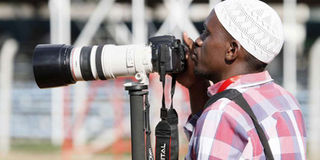Why a photo should not detract from the message of sports story

A photojournalist coves an event in Nakuru on April 23, 2014. Photos that are obscene should not be used. PHOTO | SULEIMAN MBATIAH | NATION MEDIA GROUP
What you need to know:
- The importance and news value of the picture triumphed over the ethical considerations of publishing a nude picture.
- NMG has a clear policy on the use of images. If they are obscene, vulgar or offensive to public good taste they should not be used.
Forty-five years ago a press photographer took pictures showing children running down a highway after a South Vietnamese plane accidentally dropped napalm on civilians.
There was a girl in the center of one of the photos who was naked.
She had discarded her burning clothes. The photo became a famous iconic image that was published in newspapers around the world.
PUBLISHED
But initially editors of Associated Press who circulated the picture were hesitant about publishing it.
The picture editor looked at the photos and asked the photographer: “Why did you take pictures of a naked girl?”
Another editor said: “We don’t think we can use the picture in the paper, because she’s too naked.”
Still another said: “You think these are pictures we can use? Because she’s naked.”
When the picture was released, it was immediately published on the front pages of newspapers and on TVs around the world.
PUBLIC INTEREST
The importance and news value of the picture triumphed over the ethical considerations of publishing a nude picture.
That the picture could be seen as obscene, vulgar or offensive to public good taste did not matter any more.
There was a clear and indisputable public and international interest in the use of the picture. It won the Pulitzer Prize.
Last week, I was confronted by readers complaining about the publication of a “naked” picture on page 55 of the Daily Nation of June 23.
OBSCENE
It was nothing of the same importance as the picture of the naked Vietnamese girl.
It was the picture of Dominic Samson, a 17-year-old Form Two student athlete from Kiendege High School in Nyamira, shown winning the 10,000 metres walk at the national secondary schools championships in Mombasa, on June 8.
He is not naked. But his genitalia hangs inside his shorts and is clearly visible in a picture splashed big across the depth of the entire page. Nothing is left to the imagination.
Martin Mbuguah Wamathwe said he was horrified by the sexually revealing picture.
“How could you let that picture get published? That fellow by now has received calls. Some praising his ‘cargo department’.
"Others taunting him. Imagine the bullying you have subjected this young fellow to!”
CROPPED PHOTO
Mr Wamathwe however said he was “sure girls are having a nice day!”
Not really, according to another complaint by Wandia Seaforth.
“I am not a prude by any standards but this is offensive. Three women in my house - me, my daughter and the house help - are upset.
"How did the editor pass this photo? I would seriously love to have a one-on-one chat with somebody at Nation about photos.”
"To be fair to the Nation, the online version cut the picture from the hips down, removing the offending thing."
CULTURAL ISSUE
But I am wondering why readers consider male display offensive but not women’s cleavage and form-fitting and skin-tight clothing that reveals “the goods”.
Could the answer lie in our patriarchal culture in which men’s bodies are not sexualised and we reserve sexuality for women? But is testicular cleavage so obscene?
Still, the readers are right. The image of Dominic Samson astride a whole page with his well-endowed manhood taking form under his sports shorts detracts from the message of the story – his exploits in the race-walk.
That message is overshadowed by the focus on his genitalia.
PUBLIC TASTE
The complainants are also right to the extent the picture is offensive to public taste.
The picture also intrusively invades the young athlete’s privacy though he has not complained as far as I know.
I will repeat what I said in the article, “Photojournalists should treat subjects as they would treat themselves”, published on January 26, 2017.
“NMG has a clear policy on the use of images. If they are obscene, vulgar or offensive to public good taste they should not be used.
"Ditto if they are ‘invasive of anyone’s privacy’, unless the use of any such images is justified by “a clear and indisputable public interest”.
Send your complaints to [email protected]. Text or call 0721989264.





